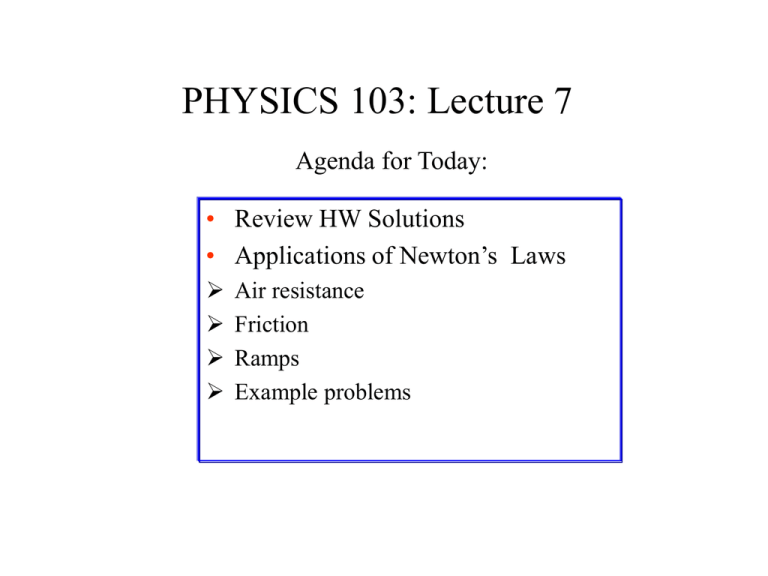
PHYSICS 103: Lecture 7
Agenda for Today:
• Review HW Solutions
• Applications of Newton’s Laws
Air resistance
Friction
Ramps
Example problems
NEWTON’S LAWS OF MOTION
FIRST LAW:
An object at rest will remain at rest and an object in
motion will remain in motion unless acted upon by an
external force.
SECOND LAW:
The net force on an object is equal to the product of
that object’s mass times its acceleration. The
acceleration is in the same direction as the force.
F=m.a
THIRD LAW:
For every force that one object exerts on a second
object, there is an equal but oppositely directed force
that the second object exerts on the first object.
The force of air resistance R acting on a sky diver
increases as the velocity increases.
R gets larger as the velocity increases
Fnet mg R
a
m
m
R
g
m
ag
If R=W then you don’t accelerate =>
you reach terminal velocity
Copyright © 2001 by The McGraw-Hill Companies, Inc. All rights reserved.
Test your understanding
Question: A man and a woman are parachuting from the
same altitude. If the man is twice as heavy as the woman, and
they have identical parachutes, who gets to the ground first?
Question: A skydiver jumps from a helicopter. As she falls
faster and faster through the air, does her acceleration
increase, decrease, or remain the same?
FRICTION
Question: When I slide a block across a table, why does
it come to a stop?
FRICTION
All surfaces are not
perfectly flat
• Opposes relative motion of two surfaces
• Acts to bring two surfaces to one velocity
• Is a reactionary force
• Comes in two kinds : static and sliding
FRICTION
Static Friction:
-acts to prevent objects from starting to slide -forces vary from zero to an upper limit
Sliding or Kinetic Friction:
-acts to stop objects that are already sliding
- forces have a fixed magnitude
Ff
FN
Fg
NO Friction
F
Static Friction
Static Friction
Static Friction
Kinetic Friction
FRICTION
Increases:
• When you push surfaces more tightly together
• When you make surfaces rougher
Static Friction: Ff = ms FN
Kinetic Friction:Ff = mk FN
mk < ms
Peak static force is greater than sliding force
Test your understanding
• Why is it hard to move forward in your car on ice?
• Why does sand on ice help?
• Would you rather be in a porsche or buick in snow storm?
• Does skidding make you come to a stop faster or slower?
• How do anti-lock brakes work?
Ramps
•Why can you lift a very heavy object with a ramp?
• Why is it easier to lower an object than raise it?
• Why is it more difficult to ride a bike up a steep slope than
a more gradual one?
Ff
FN
FN
Fg
q
Fg
We already learned that when all forces balance there is no motion
Unbalanced forces induce acceleration
Forces on a ramp
FN = Fg cosq
a// = g sinq
q
Fg q
Question: What is the acceleration of a 30 kg block sitting on a
frictionless ramp with a 30 degree incline if I apply a 200 N
force along the ramp?
FN = Fg cosq
We know: m = 30 kg
a// = g sinq
q
Fg = mg = 30 (9.8) N = 294 N
Fg q
a = Fnet/m = 53/30 m/s2 = 1.77 m/s2
Example Problems Distributed in Class: Test your
understanding
Main Points from Today’s Lecture
• Applications of Newton’s Laws
Air resistance
You should understand that there is a force acting against
gravity causing your acceleration to be less than g. This
force increases with velocity until it equals your weight.
You then reach terminal velocity
Friction
You should understand that friction is a reactionary force
that opposes motion. It comes in two kinds (static and
kinetic) and it is a function of how rough a surface is and
the normal force.
Ramps
You should understand how to find the net force on an
object on a ramp to find the acceleration
Example problems






